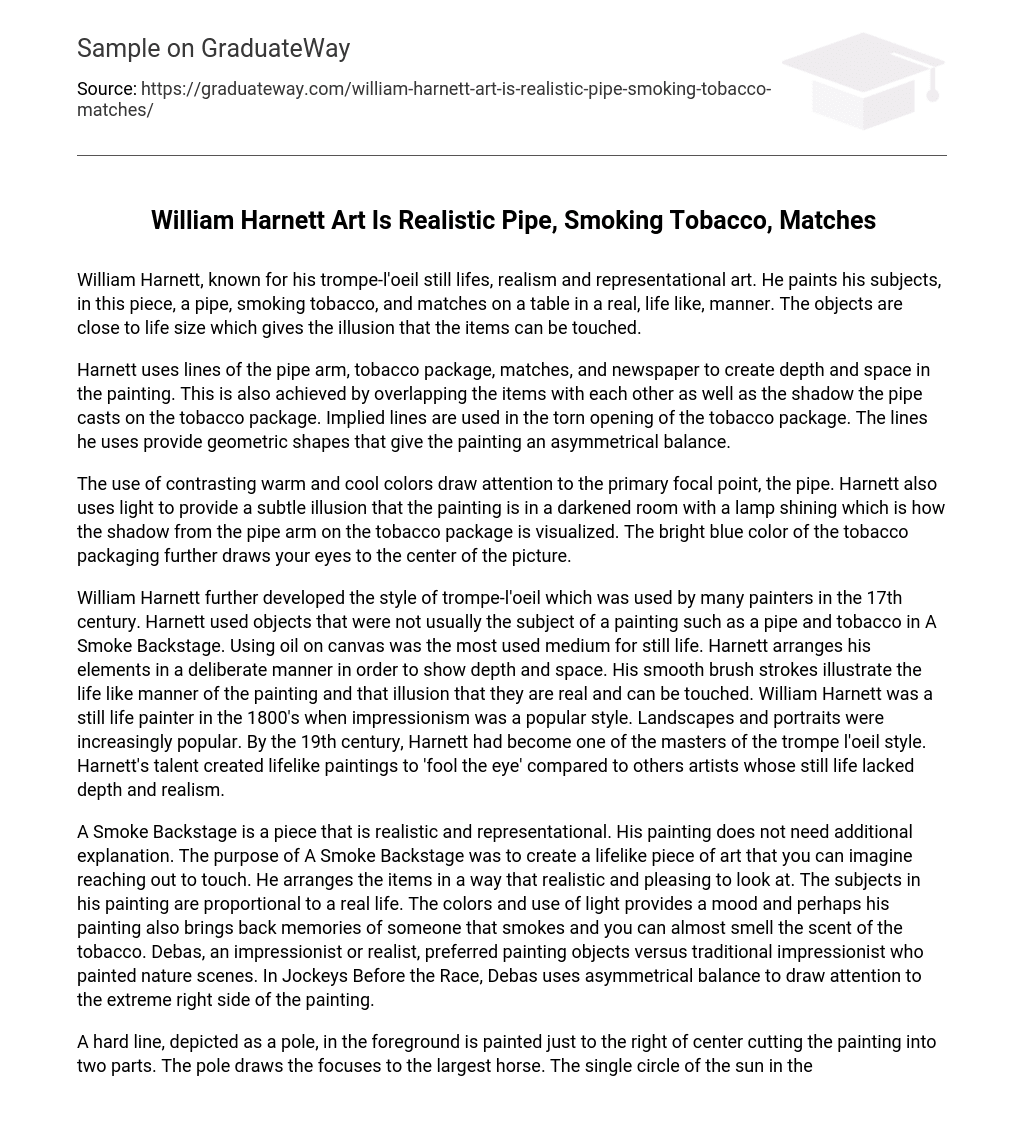William Harnett, known for his trompe-l’oeil still lifes, realism and representational art. He paints his subjects, in this piece, a pipe, smoking tobacco, and matches on a table in a real, life like, manner. The objects are close to life size which gives the illusion that the items can be touched.
Harnett uses lines of the pipe arm, tobacco package, matches, and newspaper to create depth and space in the painting. This is also achieved by overlapping the items with each other as well as the shadow the pipe casts on the tobacco package. Implied lines are used in the torn opening of the tobacco package. The lines he uses provide geometric shapes that give the painting an asymmetrical balance.
The use of contrasting warm and cool colors draw attention to the primary focal point, the pipe. Harnett also uses light to provide a subtle illusion that the painting is in a darkened room with a lamp shining which is how the shadow from the pipe arm on the tobacco package is visualized. The bright blue color of the tobacco packaging further draws your eyes to the center of the picture.
William Harnett further developed the style of trompe-l’oeil which was used by many painters in the 17th century. Harnett used objects that were not usually the subject of a painting such as a pipe and tobacco in A Smoke Backstage. Using oil on canvas was the most used medium for still life. Harnett arranges his elements in a deliberate manner in order to show depth and space. His smooth brush strokes illustrate the life like manner of the painting and that illusion that they are real and can be touched. William Harnett was a still life painter in the 1800’s when impressionism was a popular style. Landscapes and portraits were increasingly popular. By the 19th century, Harnett had become one of the masters of the trompe l’oeil style. Harnett’s talent created lifelike paintings to ‘fool the eye’ compared to others artists whose still life lacked depth and realism.
A Smoke Backstage is a piece that is realistic and representational. His painting does not need additional explanation. The purpose of A Smoke Backstage was to create a lifelike piece of art that you can imagine reaching out to touch. He arranges the items in a way that realistic and pleasing to look at. The subjects in his painting are proportional to a real life. The colors and use of light provides a mood and perhaps his painting also brings back memories of someone that smokes and you can almost smell the scent of the tobacco. Debas, an impressionist or realist, preferred painting objects versus traditional impressionist who painted nature scenes. In Jockeys Before the Race, Debas uses asymmetrical balance to draw attention to the extreme right side of the painting.
A hard line, depicted as a pole, in the foreground is painted just to the right of center cutting the painting into two parts. The pole draws the focuses to the largest horse. The single circle of the sun in the upper left corner also draws the eyes to the left side of the painting. Decreasing the size of the horses help move your eyes towards the left side of the painting. There is a small vertical line on the left that was purposefully painted to draw your attention upward.
Debas uses subtle warm and cool colors in the horizon that softens the background and draws attention to the foreground of the darkness of the horses, and the bold red hat of a jockey. His use of light and dark provides a richness on surfaces and implies movement in the horses. Edgar Debas experimented with unusual techniques. He would combine pastels and oils in a single painting to achieve strong contrast of light and dark which results in a richness of surface effects and texture. His key themes were ballerinas and racecourse.
Edgar Degas is regarded as one of the founders if impressionism. He preferred realist. Degas used the techniques of the masters while creating methods of his own. Jockeys Before the Race is a realistic piece that can further invoke the imagination, creating your own story. The purpose was to capture the calm before the race and suggests snapshot into horse racing. The asymmetrical painting forces you to scan the entire picture with each area having its own focal point. Debas communicated a relaxed, informal setting through his choice of soft colors of the background and the boldness of the horse in the foreground.





